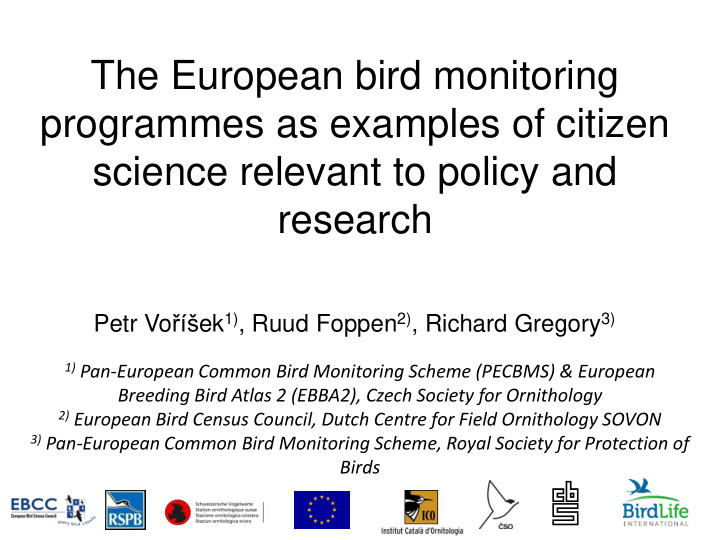



The European bird monitoring programmes as examples of citizen science relevant to policy and research Petr Vo říš ek 1) , Ruud Foppen 2) , Richard Gregory 3) 1) Pan-European Common Bird Monitoring Scheme (PECBMS) & European Breeding Bird Atlas 2 (EBBA2), Czech Society for Ornithology 2) European Bird Census Council, Dutch Centre for Field Ornithology SOVON 3) Pan-European Common Bird Monitoring Scheme, Royal Society for Protection of Birds
Pan-European Common Bird Monitoring Scheme Source of data: national/regional monitoring schemes Standardised methods Volunteer fieldworkers > 11 000 1km 500m 27 countries, 163 species www.ebcc.info/pecbm.html in 2014
Decline of farmland birds in Europe www.ebcc.info/trends2014.html www.ebcc.info/indicators2014.html
Impact of climate change on European birds 110 110 (B) Weighted population trend of species predicted to lose (A) Weighted population trend of species predicted to gain 105 range in response to climatic change (92 species) 105 range in response to climatic change (30 species) 100 100 Weighted population inde Weighted population inde 95 95 90 90 85 85 80 80 75 75 70 70 65 65 60 60 1980 1985 1990 1995 2000 2005 1980 1985 1990 1995 2000 2005 Year Year Species predicted to decline are already declining Species predicted to increase are already increasing Gregory et al. 2009. PLoS ONE 4(3): e4678. doi:10.1371/journal.pone.0004678
Common species in Natura2000 sites in EU
New European Breeding Bird Atlas (EBBA2) Commenced in 2012 Will be finished by 2020
Pilot data collation 2014
Difficult countries: Russia (c. 40% of Europe) Complete data by Mikhail Kalyakin & Olga Voltzit Qualitative data Data for a part of the square Data have been promised
EuroBird Portals (EBP) Initiative Online bird portals Diversity of online bird data gathering platforms in Europe
Goal To describe large scale spatiotemporal patterns of bird distribution (seasonal distributional changes, migratory patterns, phenology) and their changes over time. Barn swallow spring migration front (preliminary approach)
Our vision • To know bird numbers and distribution • To understand changes • To make decision makers to use the information properly • Integration of censuses, atlases and portals • Need feedback from policy • Need support
Acknowledgments Our thanks go to numerous amateur ornithologists who count birds in field for national monitoring schemes . National coordinators of common bird monitoring schemes and breeding bird atlases. Collegues in PECBMS, EBBA2 and EBP: Jana Škorpilová, Martin Kupka, Sergi Herrando, Verena Keller, Gabriel Gargallo.
Recommend
More recommend